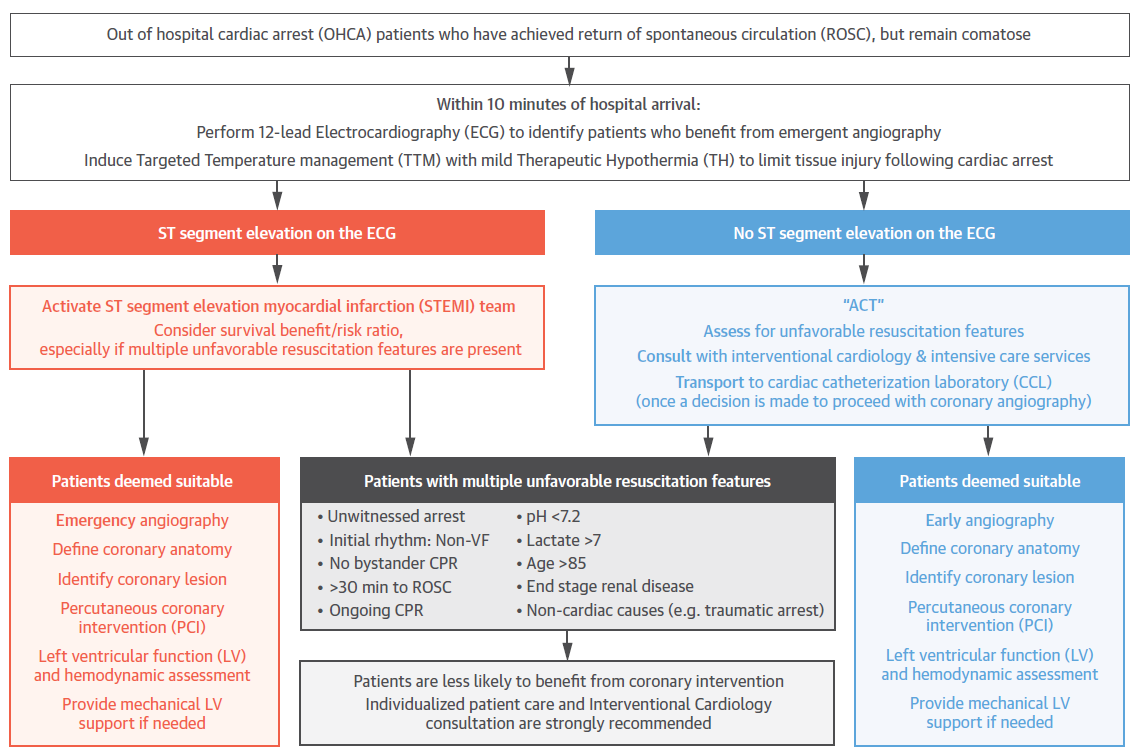Cardiac Arrest: A Treatment Algorithm for Emergent Invasive Cardiac Procedures in the Resuscitated Comatose Patient
A "state of the art review," published by members of the American College of Cardiology (ACC) Interventional Council and their colleagues in the July 7, 2015 issue of The Journal of the American College of Cardiology, addresses the issue of emergent invasive cardiac procedures in the resuscitated comatose patient, following cardiac arrest.
This topic, of foremost importance to the interventionalists, has been brought up repeatedly before the Interventional Council due to the high mortality rate following percutaneous coronary intervention (PCI) in this population. The council was concerned that public reporting and pay-for-performance initiatives that focused on total PCI mortality could result in risk averse behavior on the part of the interventionalists and patients who would not receive appropriate care. This was most apparent in patients without ST elevation on the electrocardiogram as there are no consensus guidelines in this setting.
While neither the manuscript nor the algorithms are "guidelines," nor are they endorsed by the ACC, they nevertheless represent a long overdue structured approach for interventionalists and teams taking care of these very sick patients. The highlight of the manuscript is the central illustration of a suggested algorithmic approach to risk stratification (Figure 1). It was designed to be a simple, easily understood tool to be used by emergency department physicians, cardiologists, and critical care specialists for rapid assessment and management of these patients. While there are no large randomized trials in this field, the literature was reviewed extensively to form the basis of this algorithm.
The algorithm emphasizes that providers assess and consult before transporting these patients to the catheterization laboratory for the best possible outcome. While most patients with cardiac arrest benefit from urgent targeted temperature management, invasive angiography, and culprit lesion revascularization, selected patients with multiple unfavorable factors should be only offered comfort measures due to high likelihood of futility. In order not to influence these decisions with concerns over public reporting and pay-for-performance, the paper endorses the American Heart Association's (AHA) recommendations to exclude these patients from public reporting (and pay-for-performance) but collect the data to track outcomes.
Figure 1: Algorithm for Risk Stratification of Comatose Cardiac Arrest Patients
Reproduced with permission from Rab T, Kern KB, Tamis-Holland JE, et al. Cardiac arrest: a treatment algorithm for emergent invasive cardiac procedures in the resuscitated comatose patient. J Am Coll Cardiol 2015;66:62-73.
Keywords: Algorithms, American Heart Association, Angiography, Cardiac Catheterization, Cardiopulmonary Resuscitation, Catheterization, Coma, Critical Care, Electrocardiography, Emergency Service, Hospital, Heart Arrest, Hypothermia, Induced, Medical Futility, Myocardial Infarction, Out-of-Hospital Cardiac Arrest, Percutaneous Coronary Intervention, Reimbursement, Incentive, Specialization, Temperature, Ventricular Fibrillation
< Back to Listings

